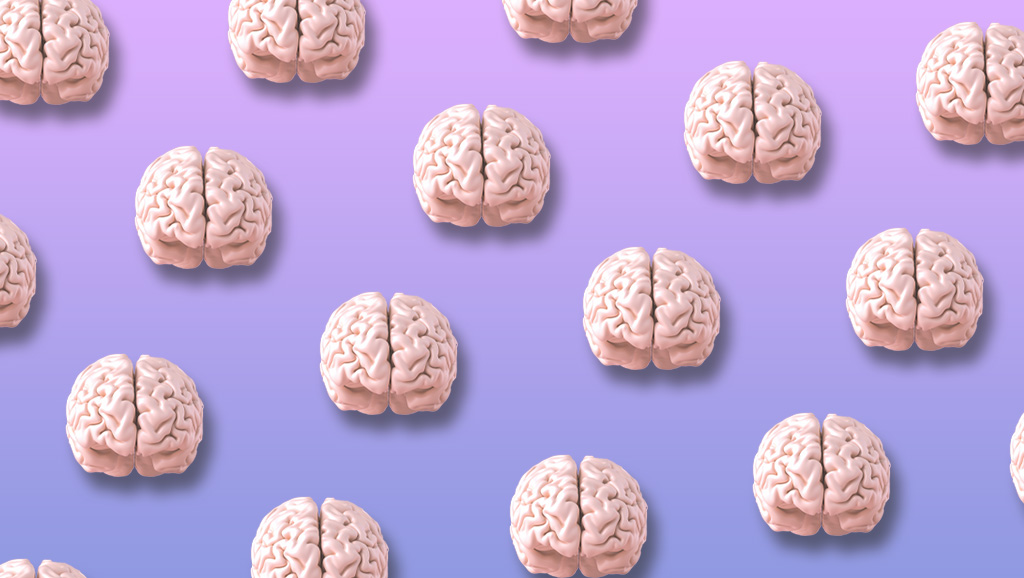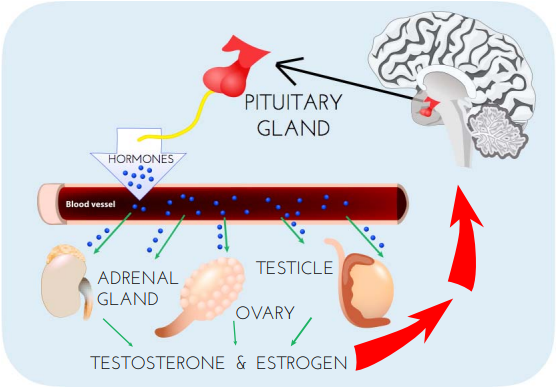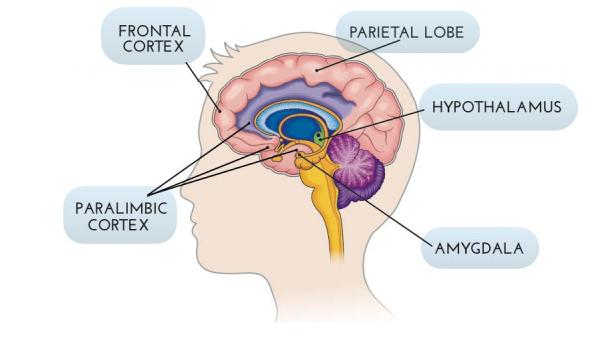Fact Sheet
Sex Hormones and the Brain
Who this is for:

Many of us think of hormones as chemical messengers that arrive during puberty to govern our reproductive development. But sex steroids like testosterone and estrogen also play a critical role in brain development.
Biological sex, a category that generally includes male, female, and intersex, classifies organisms based on anatomical, reproductive, and genetic characteristics. While most people know that male, female, and intersex individuals show distinct anatomical differences in their nether regions, there also remains a pervasive notion that the biological sexes are quite different when it comes to behavior and temperament—key differences that extend beyond those seen in physical anatomy. (Note: This article will primarily discuss male/female development. Given the variability in intersex individuals as a category, more research is necessary to understand the ways sex hormones may affect the brain).
While some beliefs about male and female behavior are rooted in outdated gender stereotypes, we know that sex and gender identity are distinct concepts – and operate on different spectrums. When examining biological sex, neuroscientists have learned there are quite noticeable variances between the brains of males and females in terms of structure, volume, and function. Sex hormones, like estrogen and testosterone, can target regions of the brain in different ways, affecting aspects of signaling and function at the epigenetic, cellular, and behavioral levels.
You may remember learning about estrogen and testosterone in middle school health class. Historically, experts have referred to these chemical messengers as “female” and “male” hormones, respectively—and talked about their role in governing reproductive development during puberty. But these sex steroids also play a critical role in brain development, even before adolescence, by shaping, activating, and fueling sexually dimorphic brain circuits. While sex steroids are most often discussed in relation to romantic and sexual brain circuits, they are certainly not limited to those areas. In fact, many of these brain networks have been implicated in complex behaviors including the stress response, learning, and memory. They’ve even been linked to the development of several psychiatric disorders.
What Is Sexual Dimorphism?
We often discuss sexual dimorphism in terms of physical, sex-specific attributes. Think of the peacock tail: Males have long, brightly colored feathers while females sport shorter, duller plumage. But you can also see these sorts of observable, phenotypic differences in the brain. These biological sex differences arise not only from epigenetic hormone actions during developmental sensitive periods as our brains grow throughout childhood—but also from our individual experiences interacting with the outside world. The end result is visible differences in terms of size, appearance, and function of the brain between the biological sexes across species.
Hormones as Neurotransmitters
How do hormones such as estrogen and testosterone so powerfully affect the brain? They can act as neurotransmitters, much like serotonin or glutamate, affecting neural signaling and activity across the brain.
You can find receptors for sex steroids on cells across the entire body. Those receptors receive the hormone messengers released into the bloodstream by endocrine glands, like the pituitary gland and the thyroid gland, which help mediate cell metabolism and homeostasis.

The brain, in particular, has a wide distribution of receptors for hormones like estrogen and testosterone, which allows these sex steroids to affect a multitude of brain circuits, influencing how, where, and when brain cells communicate.
Many scientists hypothesize that sex steroids act as a type of signaling mediator, helping other neurotransmitters and neuropeptides do their job more efficiently. Researchers who study hormones at the molecular level sometimes refer to them as “gate openers,” helping cells send out and receive other important neurochemicals. That mediation is important: It may ultimately influence human behavior by helping to direct our attention to specific items in the environment, or making certain stimuli more appealing.
Hormones and Brain Development
Sex steroids also help guide brain development. That guidance begins in the womb, starting with genes present on the X and Y chromosomes. As you may know, an individual’s biological sex can be defined by these chromosomes. Females have two X chromosomes, while males have one X and one Y.
A variety of genes on these chromosomes help to provide a blueprint for the brain’s architecture. For example, the Y chromosome contains a gene called SRY, which triggers a flood of androgens (the group of hormones that includes testosterone) in the womb during the first trimester. This flood not only directs the development of the penis and testes, but also drives changes to the brain’s architecture, setting the stage for more typical “male” brain circuitry.
You can see such sexually dimorphic changes in the brain in terms of both structure and volume. As you might expect, the hypothalamus (the brain region implicated in sexual and reproductive behaviors) shows distinct differences between the sexes. But researchers have also found differences in brain regions and circuits linked to memory, emotion, and stress. For example, females tend to show a slightly larger brain volume in regions like the frontal and paralimbic cortex, while males have more bulk in the amygdala and the parietal lobe.

If you dive deeper, you can also see changes at the cellular and molecular levels. For example, biological sexes show differences in both cell and receptor density in certain brain regions. Females, for example, show a greater density of neurons in certain language areas, as well as in the frontal lobe.
It is interesting to note that most sexually dimorphic brain regions are those that have the highest density of sex steroid receptors. The combination of hormones and experiences has the power to shape the brain, often in sex-specific ways, which lead to physical differences, but also, perhaps, the stereotypical gender roles that reflect cultural influences.
Yet, that said, one of the most important things to understand about sexual dimorphism is that different does not necessarily mean better. In fact, Geert de Vries, a researcher at Georgia State University, hypothesizes that sexually dimorphic brain circuits may actually be compensatory—different enough so that males and females, who have different levels of sex steroids coursing through the bloodstream and the brain, can have similar behavioral outputs. Thus, in some activities, like spatial problem-solving or short-term memory tasks, the brain differences allow males and females to use different strategies to achieve similar levels of performance. Simply put, despite the differences, the biological sexes do many of the same things equally well but use different strategies and brain circuits to get the job done.
Sexual Dimorphism and Psychiatric Disorders
It’s well-established that most psychiatric disorders show different prevalence rates between the sexes. Depression and anxiety are more commonly seen in females, while the risk of schizophrenia is higher in males. Research studies suggest that some of those differences may be linked to hormones and how they act upon sexually dimorphic brain circuits. For example, one study suggests that females with major depressive disorder show low activation of the brain’s stress circuitry along with lower estrogen levels. Other work has shown that low testosterone levels are correlated with increased risk of psychosis in males.
Because, traditionally, research programs in science and medicine have only studied males across species, we are only beginning to understand all the ways that hormones might influence cognition, behavior, and disease. But a paradigm shift is occurring in neuroscience, with the National Institutes of Health enacting a sweeping policy change in 2014, then updating it with further guidance in 2017. This change incentivizes scientists to take a closer look at sex in their research programs. This will afford the scientific community new opportunities to investigate how sex steroids affect the brain in development and beyond.
*Updated March 2024